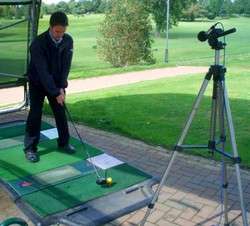Which Is King Of Clubs In The Noise Stakes?

(PhysOrg.com) -- New generation thin-faced titanium golf clubs can produce sound levels nearly twice as loud as traditional steel clubs when they hit a ball, according to new research.
The new University of Derby research has been profiled on national sports radio station TalkSport, The Daily Telegraph and on the national BBC website, as a result of this press release.
But using any club tested in the study is unlikely to exceed the legal levels as cited within the Control of Noise at Work Regulations (2005) with its daily noise exposure value of 80dB.
Golfers would have to hit more than 1,000 balls in a single session to go over the daily legal noise exposure limit.
Environmental Health Officer and University postgraduate student Ben Ellis wanted to assess the noise levels of the new generation titanium golf clubs for health and safety reasons, after reading a case in the British Medical Journal about a golfer who claimed to have suffered hearing loss from using such clubs three times a week for 18 months.
The golfer had tests at hospital after he attended a clinic with unexplained tinnitus and reduced hearing in his right ear, and the tests confirmed that his hearing problems were typical of those whom are exposed to high noise levels in industry. Health experts claimed that the golf drivers may produce sufficient sound to induce temporary or even permanent damage in the cochlea in the ear.
In the University of Derby's study, Ben recorded noise levels of a variety of clubs hitting a ball, when struck by golfers on a driving range in Northamptonshire, using an integrating sound level meter.
He discovered that traditional golf clubs recorded an average SEL (Single Event Level) noise level of 86 dB (decibels), with titanium clubs recording an average of 94 dB - nearly three times the total sound energy. A ten decibel increase is perceived as a doubling in loudness to the human ear.
But even the titanium clubs are within health and safety levels when tested against the Control of Noise at Work 2005 regulations - a golfer would have to hit at least 1,046 balls in a single session before the daily noise exposure level would contravene these laws.
However, if a player did hit this number of balls in a session using these clubs, it would then require the golf club to provide ear plugs or take other measures to protect the health and safety of players.
Ben, 30, an Environmental Health Officer at Daventry District Council, said: "There was a big difference in the sound levels of the new titanium clubs in relation to the other clubs.
"But while titanium clubs are louder, they are within the Control of Noise at Work Regulations (2005), suggesting it will not impact on a golfer's health, according to these regulations.
"I also worked with a professional golfer, an amateur with a handicap of 13 and one with a handicap of 28 to see if the handicap had a bearing on the noise levels. It did, but certain clubs appeared to make more noise in the amateur's hands whilst others produced the most noise when used by a professional."
Ben is just one of the success stories from this year's cohort of students studying on the postgraduate course at Derby, managed by Dr John Pritchard, Senior Lecturer in Acoustics and Environmental Science. Ben is also now starting an MSc in Applied Acoustics at Derby this month.
Dr Pritchard said: "While a player would have to hit more than 1,000 balls in a session to contravene these regulations using these new generation clubs, health experts suggest that a sharp impulse sound such as hitting a golf ball with a club could be more dangerous to long-term hearing than being exposed to a continuous sound such as a drill."
Ben's average SEL noise readings for each club when hit by a professional golfer were as follows:
• New titanium club - 94 dB
• New titanium club - 94 dB
• New titanium club - 93 dB
• A slightly older modern club (titanium) 93dB
• A club ten years old (titanium) 87 dB
• A modern steel headed driver 86dB
• A five iron golf club 79 dB
• A five iron golf club 79 dB
The University enjoys strong links with industry and last night (TUE) hosted the regional Institute of Acoustics (IOA) meeting at the University's Kedleston Road. The Institute also accredits Derby's noise and acoustics courses, including the postgraduate diploma Ben has just completed.
At the event, more than 40 delegates listened to presentations from some of the students about their work this year. Other presentations include Janine Dickinson, talking about noise impact from outdoor concerts and Tom Lucas discussing the uncertainties in sound insulation testing.
The IOA is the leading organisation in the United Kingdom concerned with Acoustics, and provides a range of educational courses and coordinates a number of conferences during the year.
Dr Pritchard added: "We were delighted to welcome the Institute of Acoustics to the University with the chance for members to hear some of the research work carried out by our students in the last academic year.
"The research is applied, often providing important ways forward for the industry and it's important that the institute, which accredits our courses, has the opportunity to hear about some of the exciting work students have been involved in."
Provided by University of Derby














